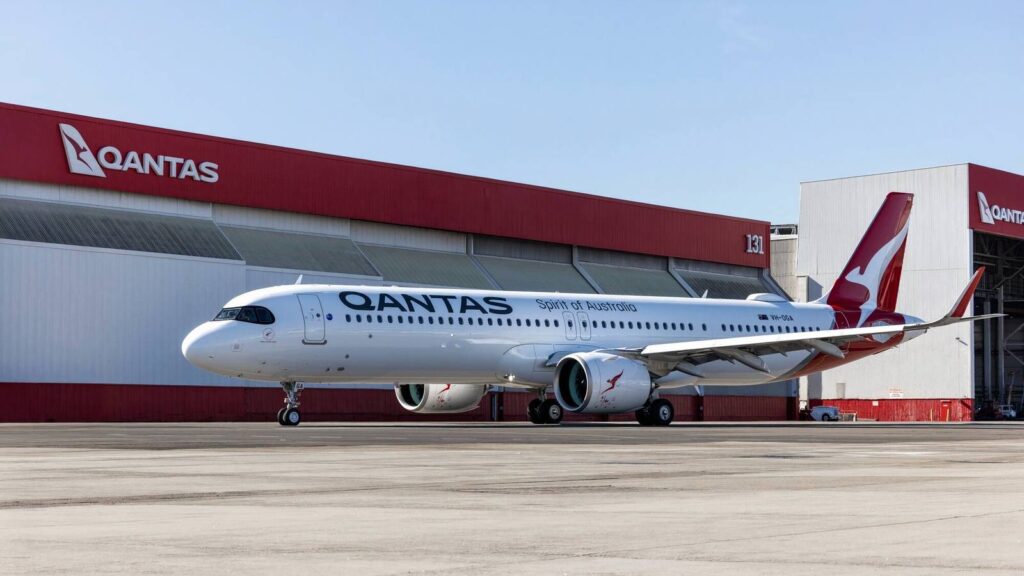
Qantas has announced a significant expansion of its Airbus A321XLR fleet, increasing its order to 48 aircraft. Notably, 16 of these will feature lie-flat business seats and seatback entertainment, with the first delivery expected in 2028. This move follows Etihad Airways’ introduction of its A321LR, which includes two first-class suites and 14 fully flat business beds, highlighting a growing trend towards enhanced comfort on narrowbody aircraft.
The introduction of these A321XLRs with upgraded business class amenities positions Qantas to offer a long-haul narrowbody product, suitable for extended international routes. While these aircraft will operate from various hubs, Perth and Adelaide have been identified as key bases for potential new services.
Understanding the A321XLR’s Range Capabilities
The Airbus A321XLR boasts a theoretical range of 4,700 nautical miles (8,704 km), but real-world operations often fall short of this figure. Iberia, the launch customer, reports a practical range closer to 3,920 nautical miles (7,260 km) with its configuration. For Qantas, a more realistic range might be around 4,000 nautical miles (7,408 km), considering operational variables such as payload and headwinds.
This range opens up numerous possibilities for new routes from Perth, which currently serves six international destinations: Auckland, Johannesburg, London Heathrow, Paris CDG, Rome Fiumicino, and Singapore. The A321XLR could potentially replace larger aircraft on routes like Auckland and Singapore, possibly increasing flight frequency.
Exploring New Route Opportunities from Perth
Perth’s geographical position and market demand suggest several intriguing possibilities for new international routes. Analysis of booking data for July 2024 to June 2025 reveals Perth’s largest unserved markets within the A321XLR’s range:
- Delhi: 50,000 passengers (but beyond range)
- Christchurch: 36,000 passengers
- Hanoi: 31,000 passengers
- Wellington: 24,000 passengers
- Queenstown: 23,000 passengers
- Mumbai: 19,000 passengers
- Colombo: 18,000 passengers
While Delhi emerges as the largest unserved market, its distance of 4,243 nautical miles (7,858 km) exceeds the A321XLR’s operational range. Instead, Bengaluru, at 3,482 nautical miles (6,449 km), presents a viable option despite its smaller market size of 12,000 passengers.
Potential for Nonstop Flights to India
The prospect of launching Perth’s first nonstop flights to India is compelling. Qantas’ existing codeshare with IndiGo, which already connects Sydney to Bengaluru, strengthens this possibility. Approximately 40% of passengers on this route connect to further destinations via IndiGo, suggesting potential demand from Perth.
However, the challenge lies in the relatively small local market size compared to Sydney-Bengaluru. Nonstop flights typically rely on strong local demand to ensure profitability, as direct passengers yield higher revenue than those connecting through other hubs.
Strategic Implications and Future Outlook
The introduction of the A321XLR with enhanced business class amenities aligns with Qantas’ strategy to expand its international footprint while maintaining passenger comfort. This development reflects a broader industry trend towards utilizing narrowbody aircraft for longer routes, providing flexibility and cost efficiency.
As Qantas evaluates potential new routes from Perth, factors such as market demand, competitive dynamics, and operational feasibility will be crucial. The airline’s ability to fill its lie-flat business seats consistently will determine the success of these new services.
Looking ahead, the expansion of Qantas’ A321XLR fleet represents a significant step in its growth strategy, offering new opportunities to connect Australia with key international markets. As these aircraft enter service, passengers can anticipate enhanced comfort and convenience on a wider range of routes.





